Medical Genetics and Genomics Coursework: Genetic Condition Report
VerifiedAdded on 2022/08/24
|9
|1490
|20
Homework Assignment
AI Summary
This Medical Genetics and Genomics assignment presents a comprehensive analysis of Neurofibromatosis type 1 (NF1), detailing its genetic mutations, symptoms, and inheritance patterns. The report includes a discussion of the NF1 gene, its locus, and the nature of mutations, along with the analysis of pedigree diagrams to determine inheritance patterns. The assignment also addresses questions on genetic crosses, allele frequencies, and the analysis of data related to gene expression and mutations. Additional questions cover topics from the identification of phenotypes associated with SERPINA1 to the application of genetic principles in various scenarios. The student provides answers to a variety of questions, including analysis of pedigree diagrams, genetic crosses, and allele frequencies, demonstrating an understanding of core genetics concepts and their application to real-world scenarios. The assignment also includes the analysis of genetic data from databases such as NCBI, Ensembl and data interpretation from tables and diagrams. The student also utilizes data analysis techniques to determine allele frequencies and the likelihood of carriers within a population.
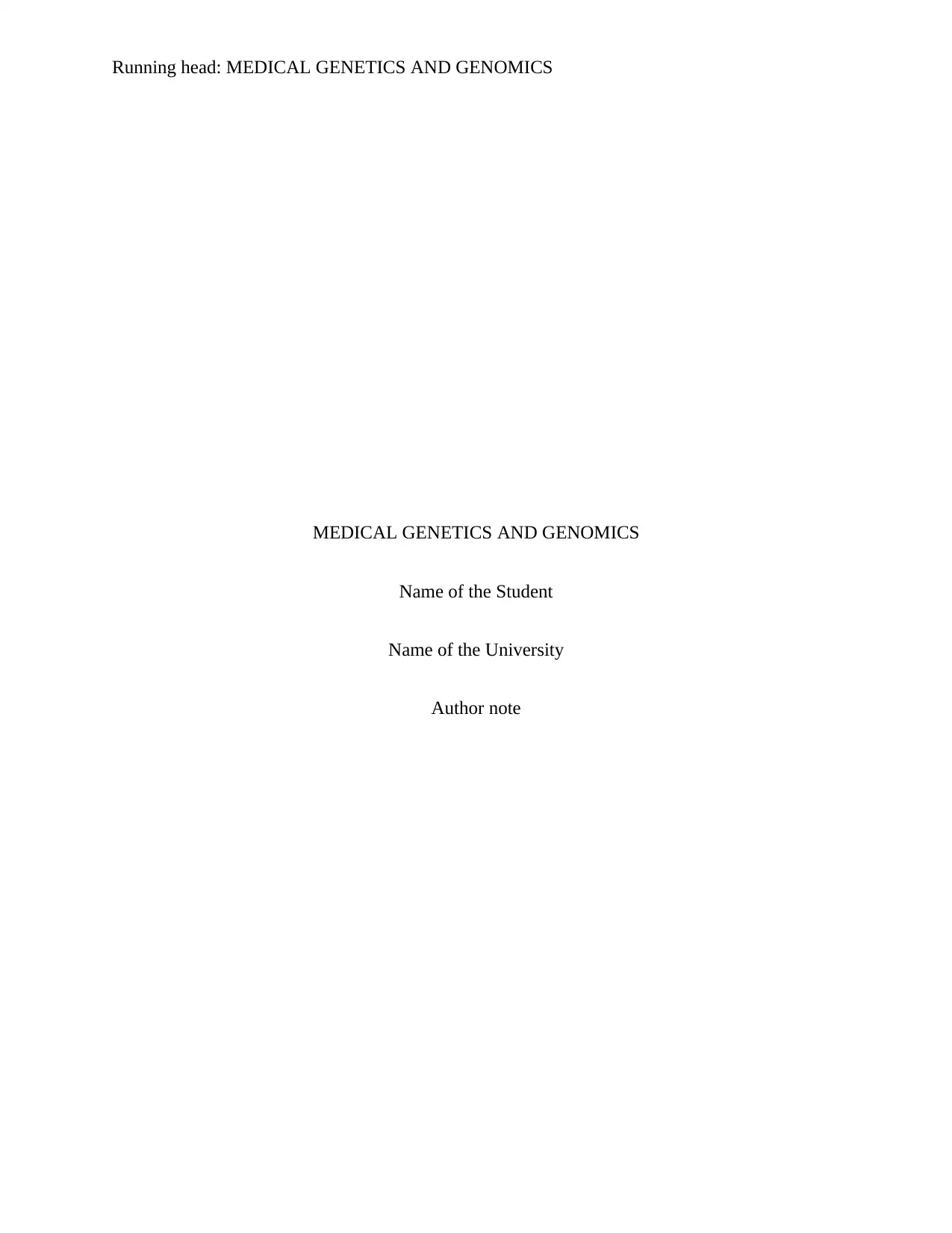
Running head: MEDICAL GENETICS AND GENOMICS
MEDICAL GENETICS AND GENOMICS
Name of the Student
Name of the University
Author note
MEDICAL GENETICS AND GENOMICS
Name of the Student
Name of the University
Author note
Paraphrase This Document
Need a fresh take? Get an instant paraphrase of this document with our AI Paraphraser
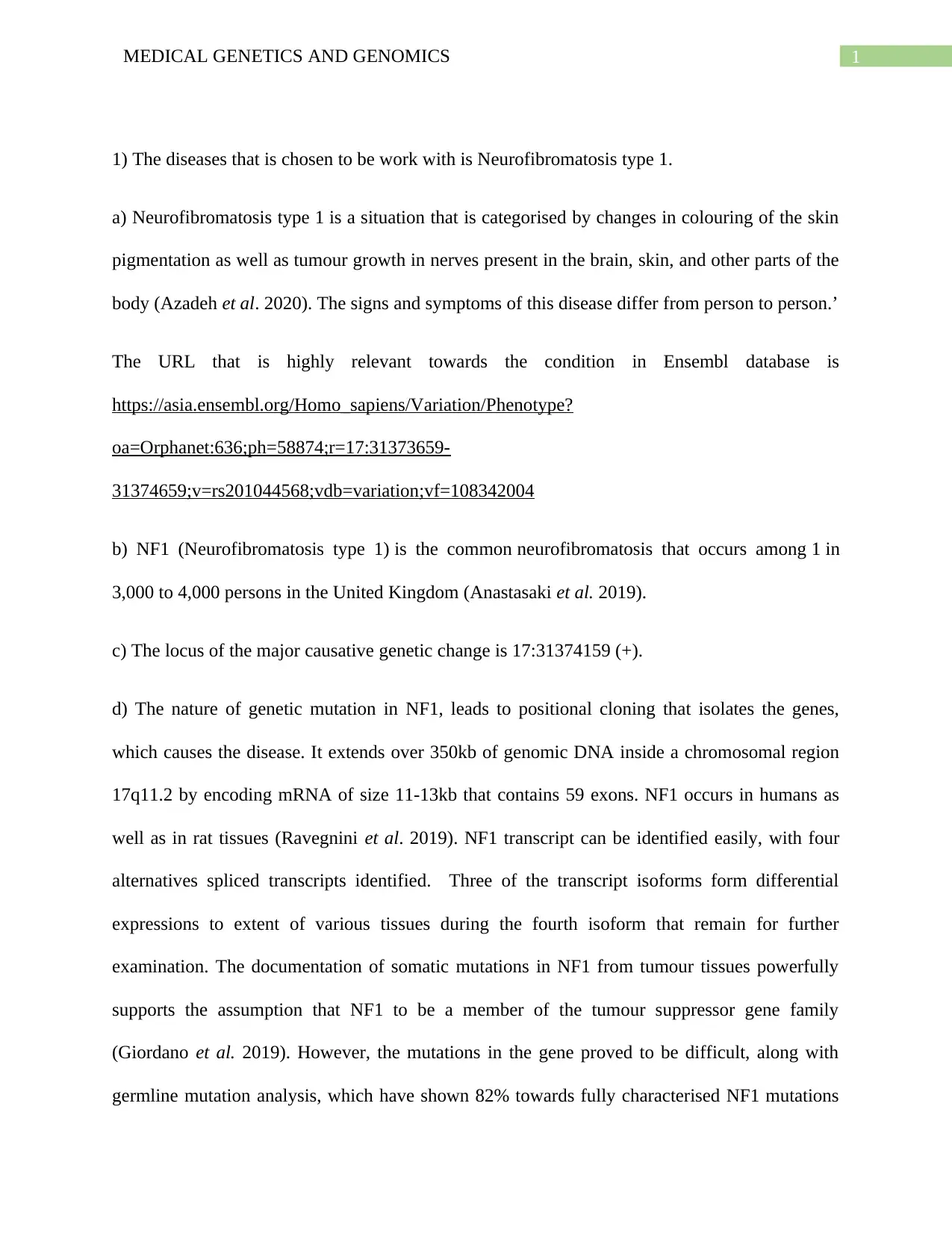
1MEDICAL GENETICS AND GENOMICS
1) The diseases that is chosen to be work with is Neurofibromatosis type 1.
a) Neurofibromatosis type 1 is a situation that is categorised by changes in colouring of the skin
pigmentation as well as tumour growth in nerves present in the brain, skin, and other parts of the
body (Azadeh et al. 2020). The signs and symptoms of this disease differ from person to person.’
The URL that is highly relevant towards the condition in Ensembl database is
https://asia.ensembl.org/Homo_sapiens/Variation/Phenotype?
oa=Orphanet:636;ph=58874;r=17:31373659-
31374659;v=rs201044568;vdb=variation;vf=108342004
b) NF1 (Neurofibromatosis type 1) is the common neurofibromatosis that occurs among 1 in
3,000 to 4,000 persons in the United Kingdom (Anastasaki et al. 2019).
c) The locus of the major causative genetic change is 17:31374159 (+).
d) The nature of genetic mutation in NF1, leads to positional cloning that isolates the genes,
which causes the disease. It extends over 350kb of genomic DNA inside a chromosomal region
17q11.2 by encoding mRNA of size 11-13kb that contains 59 exons. NF1 occurs in humans as
well as in rat tissues (Ravegnini et al. 2019). NF1 transcript can be identified easily, with four
alternatives spliced transcripts identified. Three of the transcript isoforms form differential
expressions to extent of various tissues during the fourth isoform that remain for further
examination. The documentation of somatic mutations in NF1 from tumour tissues powerfully
supports the assumption that NF1 to be a member of the tumour suppressor gene family
(Giordano et al. 2019). However, the mutations in the gene proved to be difficult, along with
germline mutation analysis, which have shown 82% towards fully characterised NF1 mutations
1) The diseases that is chosen to be work with is Neurofibromatosis type 1.
a) Neurofibromatosis type 1 is a situation that is categorised by changes in colouring of the skin
pigmentation as well as tumour growth in nerves present in the brain, skin, and other parts of the
body (Azadeh et al. 2020). The signs and symptoms of this disease differ from person to person.’
The URL that is highly relevant towards the condition in Ensembl database is
https://asia.ensembl.org/Homo_sapiens/Variation/Phenotype?
oa=Orphanet:636;ph=58874;r=17:31373659-
31374659;v=rs201044568;vdb=variation;vf=108342004
b) NF1 (Neurofibromatosis type 1) is the common neurofibromatosis that occurs among 1 in
3,000 to 4,000 persons in the United Kingdom (Anastasaki et al. 2019).
c) The locus of the major causative genetic change is 17:31374159 (+).
d) The nature of genetic mutation in NF1, leads to positional cloning that isolates the genes,
which causes the disease. It extends over 350kb of genomic DNA inside a chromosomal region
17q11.2 by encoding mRNA of size 11-13kb that contains 59 exons. NF1 occurs in humans as
well as in rat tissues (Ravegnini et al. 2019). NF1 transcript can be identified easily, with four
alternatives spliced transcripts identified. Three of the transcript isoforms form differential
expressions to extent of various tissues during the fourth isoform that remain for further
examination. The documentation of somatic mutations in NF1 from tumour tissues powerfully
supports the assumption that NF1 to be a member of the tumour suppressor gene family
(Giordano et al. 2019). However, the mutations in the gene proved to be difficult, along with
germline mutation analysis, which have shown 82% towards fully characterised NF1 mutations
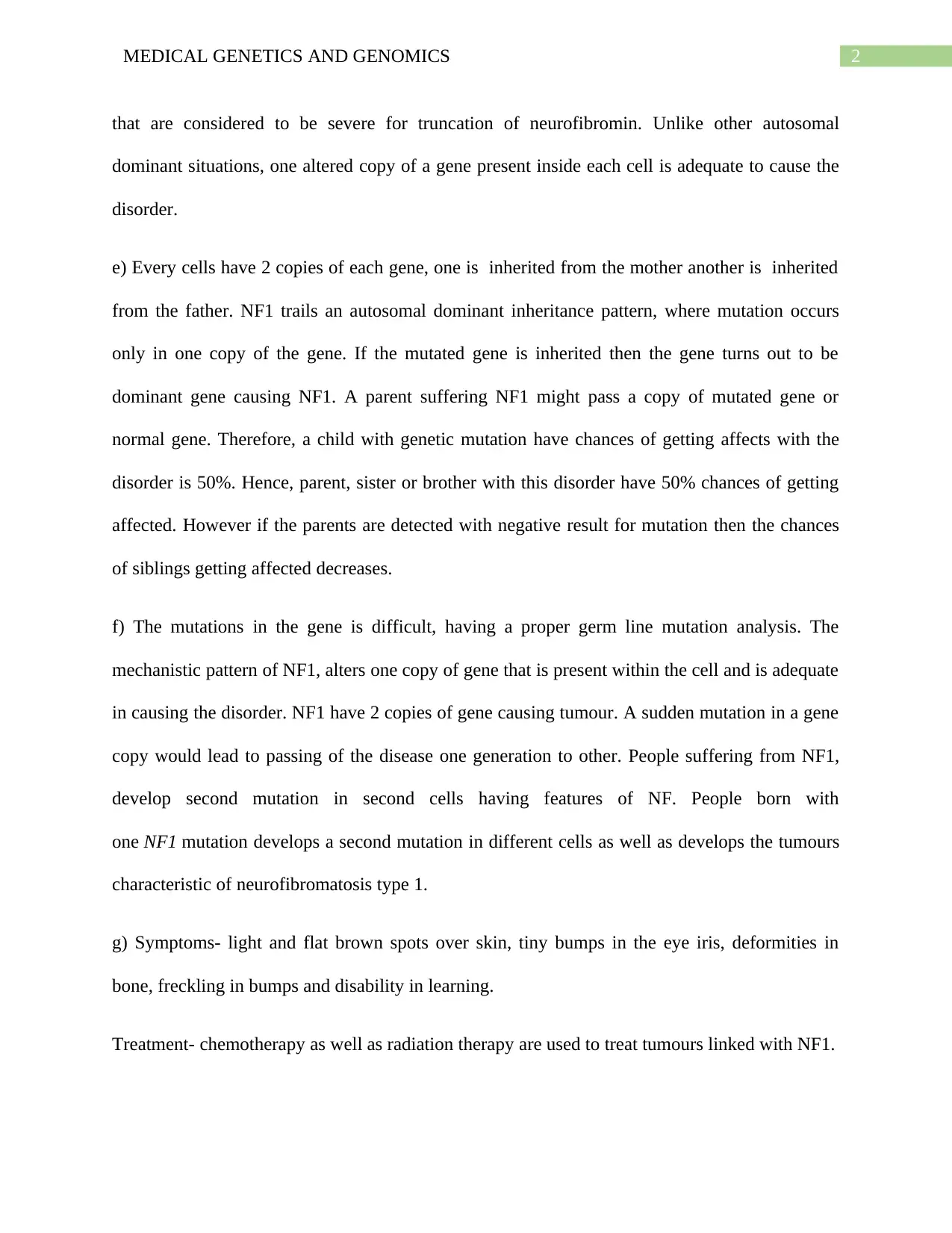
2MEDICAL GENETICS AND GENOMICS
that are considered to be severe for truncation of neurofibromin. Unlike other autosomal
dominant situations, one altered copy of a gene present inside each cell is adequate to cause the
disorder.
e) Every cells have 2 copies of each gene, one is inherited from the mother another is inherited
from the father. NF1 trails an autosomal dominant inheritance pattern, where mutation occurs
only in one copy of the gene. If the mutated gene is inherited then the gene turns out to be
dominant gene causing NF1. A parent suffering NF1 might pass a copy of mutated gene or
normal gene. Therefore, a child with genetic mutation have chances of getting affects with the
disorder is 50%. Hence, parent, sister or brother with this disorder have 50% chances of getting
affected. However if the parents are detected with negative result for mutation then the chances
of siblings getting affected decreases.
f) The mutations in the gene is difficult, having a proper germ line mutation analysis. The
mechanistic pattern of NF1, alters one copy of gene that is present within the cell and is adequate
in causing the disorder. NF1 have 2 copies of gene causing tumour. A sudden mutation in a gene
copy would lead to passing of the disease one generation to other. People suffering from NF1,
develop second mutation in second cells having features of NF. People born with
one NF1 mutation develops a second mutation in different cells as well as develops the tumours
characteristic of neurofibromatosis type 1.
g) Symptoms- light and flat brown spots over skin, tiny bumps in the eye iris, deformities in
bone, freckling in bumps and disability in learning.
Treatment- chemotherapy as well as radiation therapy are used to treat tumours linked with NF1.
that are considered to be severe for truncation of neurofibromin. Unlike other autosomal
dominant situations, one altered copy of a gene present inside each cell is adequate to cause the
disorder.
e) Every cells have 2 copies of each gene, one is inherited from the mother another is inherited
from the father. NF1 trails an autosomal dominant inheritance pattern, where mutation occurs
only in one copy of the gene. If the mutated gene is inherited then the gene turns out to be
dominant gene causing NF1. A parent suffering NF1 might pass a copy of mutated gene or
normal gene. Therefore, a child with genetic mutation have chances of getting affects with the
disorder is 50%. Hence, parent, sister or brother with this disorder have 50% chances of getting
affected. However if the parents are detected with negative result for mutation then the chances
of siblings getting affected decreases.
f) The mutations in the gene is difficult, having a proper germ line mutation analysis. The
mechanistic pattern of NF1, alters one copy of gene that is present within the cell and is adequate
in causing the disorder. NF1 have 2 copies of gene causing tumour. A sudden mutation in a gene
copy would lead to passing of the disease one generation to other. People suffering from NF1,
develop second mutation in second cells having features of NF. People born with
one NF1 mutation develops a second mutation in different cells as well as develops the tumours
characteristic of neurofibromatosis type 1.
g) Symptoms- light and flat brown spots over skin, tiny bumps in the eye iris, deformities in
bone, freckling in bumps and disability in learning.
Treatment- chemotherapy as well as radiation therapy are used to treat tumours linked with NF1.
⊘ This is a preview!⊘
Do you want full access?
Subscribe today to unlock all pages.

Trusted by 1+ million students worldwide
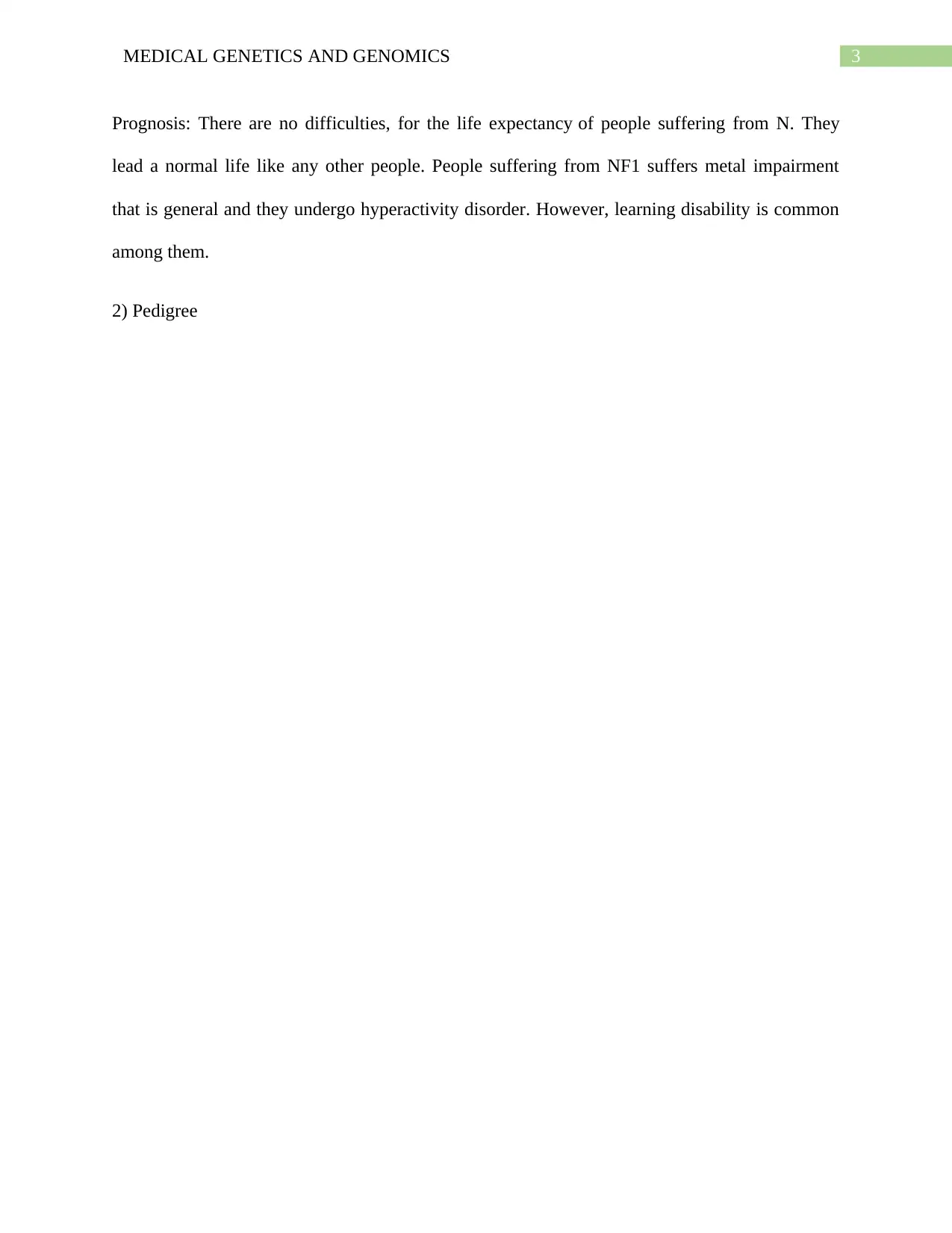
3MEDICAL GENETICS AND GENOMICS
Prognosis: There are no difficulties, for the life expectancy of people suffering from N. They
lead a normal life like any other people. People suffering from NF1 suffers metal impairment
that is general and they undergo hyperactivity disorder. However, learning disability is common
among them.
2) Pedigree
Prognosis: There are no difficulties, for the life expectancy of people suffering from N. They
lead a normal life like any other people. People suffering from NF1 suffers metal impairment
that is general and they undergo hyperactivity disorder. However, learning disability is common
among them.
2) Pedigree
Paraphrase This Document
Need a fresh take? Get an instant paraphrase of this document with our AI Paraphraser
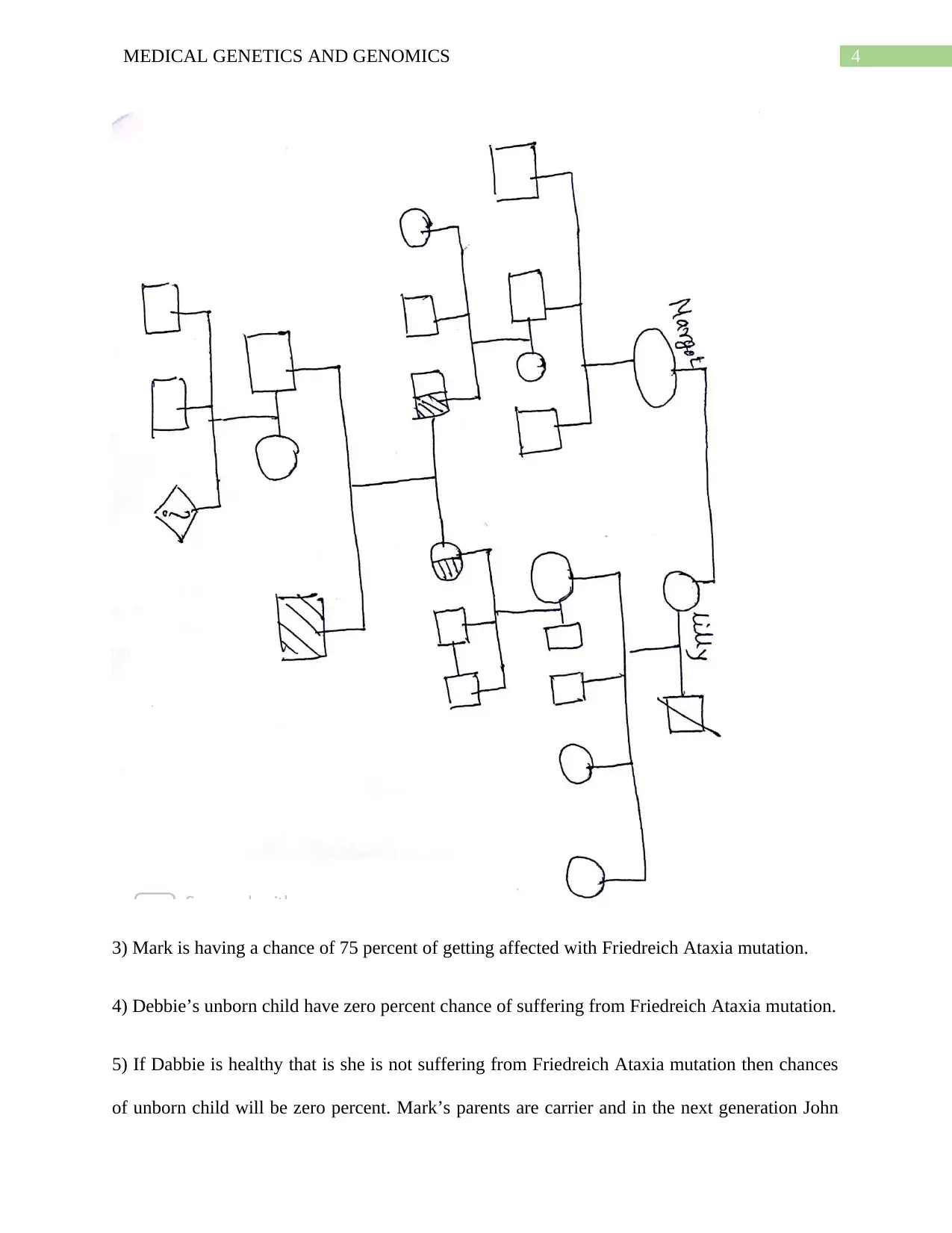
4MEDICAL GENETICS AND GENOMICS
3) Mark is having a chance of 75 percent of getting affected with Friedreich Ataxia mutation.
4) Debbie’s unborn child have zero percent chance of suffering from Friedreich Ataxia mutation.
5) If Dabbie is healthy that is she is not suffering from Friedreich Ataxia mutation then chances
of unborn child will be zero percent. Mark’s parents are carrier and in the next generation John
3) Mark is having a chance of 75 percent of getting affected with Friedreich Ataxia mutation.
4) Debbie’s unborn child have zero percent chance of suffering from Friedreich Ataxia mutation.
5) If Dabbie is healthy that is she is not suffering from Friedreich Ataxia mutation then chances
of unborn child will be zero percent. Mark’s parents are carrier and in the next generation John
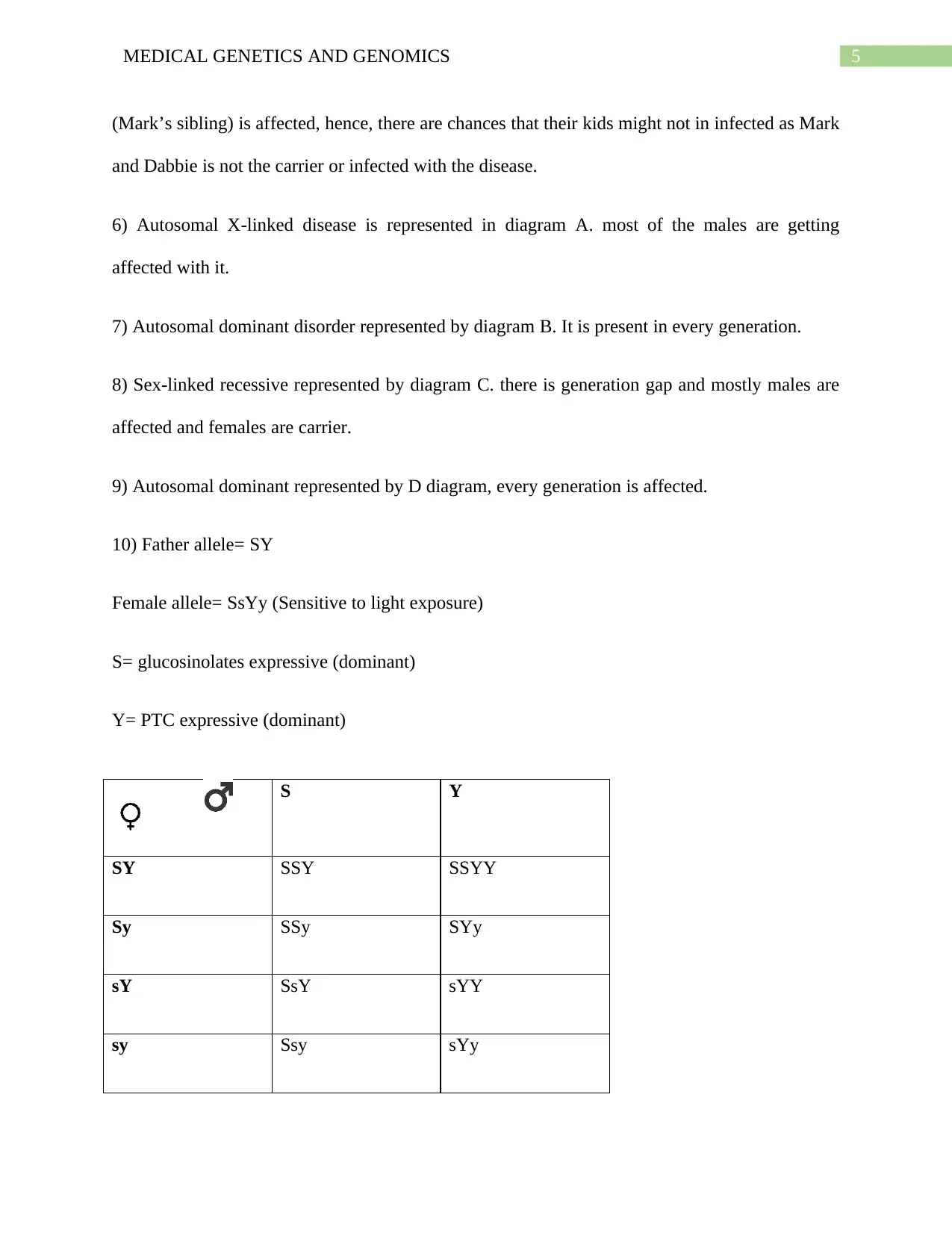
5MEDICAL GENETICS AND GENOMICS
(Mark’s sibling) is affected, hence, there are chances that their kids might not in infected as Mark
and Dabbie is not the carrier or infected with the disease.
6) Autosomal X-linked disease is represented in diagram A. most of the males are getting
affected with it.
7) Autosomal dominant disorder represented by diagram B. It is present in every generation.
8) Sex-linked recessive represented by diagram C. there is generation gap and mostly males are
affected and females are carrier.
9) Autosomal dominant represented by D diagram, every generation is affected.
10) Father allele= SY
Female allele= SsYy (Sensitive to light exposure)
S= glucosinolates expressive (dominant)
Y= PTC expressive (dominant)
S Y
SY SSY SSYY
Sy SSy SYy
sY SsY sYY
sy Ssy sYy
(Mark’s sibling) is affected, hence, there are chances that their kids might not in infected as Mark
and Dabbie is not the carrier or infected with the disease.
6) Autosomal X-linked disease is represented in diagram A. most of the males are getting
affected with it.
7) Autosomal dominant disorder represented by diagram B. It is present in every generation.
8) Sex-linked recessive represented by diagram C. there is generation gap and mostly males are
affected and females are carrier.
9) Autosomal dominant represented by D diagram, every generation is affected.
10) Father allele= SY
Female allele= SsYy (Sensitive to light exposure)
S= glucosinolates expressive (dominant)
Y= PTC expressive (dominant)
S Y
SY SSY SSYY
Sy SSy SYy
sY SsY sYY
sy Ssy sYy
⊘ This is a preview!⊘
Do you want full access?
Subscribe today to unlock all pages.

Trusted by 1+ million students worldwide
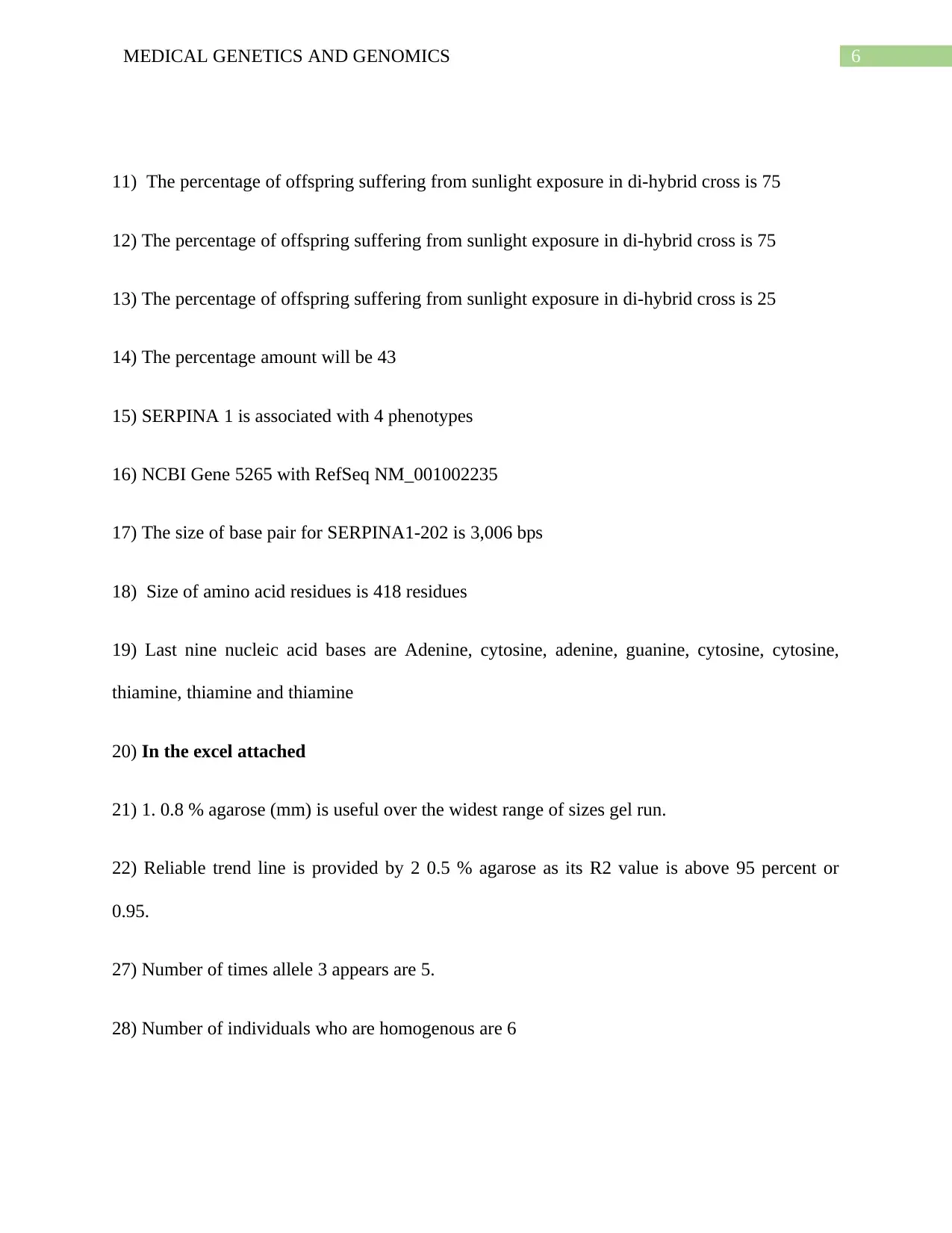
6MEDICAL GENETICS AND GENOMICS
11) The percentage of offspring suffering from sunlight exposure in di-hybrid cross is 75
12) The percentage of offspring suffering from sunlight exposure in di-hybrid cross is 75
13) The percentage of offspring suffering from sunlight exposure in di-hybrid cross is 25
14) The percentage amount will be 43
15) SERPINA 1 is associated with 4 phenotypes
16) NCBI Gene 5265 with RefSeq NM_001002235
17) The size of base pair for SERPINA1-202 is 3,006 bps
18) Size of amino acid residues is 418 residues
19) Last nine nucleic acid bases are Adenine, cytosine, adenine, guanine, cytosine, cytosine,
thiamine, thiamine and thiamine
20) In the excel attached
21) 1. 0.8 % agarose (mm) is useful over the widest range of sizes gel run.
22) Reliable trend line is provided by 2 0.5 % agarose as its R2 value is above 95 percent or
0.95.
27) Number of times allele 3 appears are 5.
28) Number of individuals who are homogenous are 6
11) The percentage of offspring suffering from sunlight exposure in di-hybrid cross is 75
12) The percentage of offspring suffering from sunlight exposure in di-hybrid cross is 75
13) The percentage of offspring suffering from sunlight exposure in di-hybrid cross is 25
14) The percentage amount will be 43
15) SERPINA 1 is associated with 4 phenotypes
16) NCBI Gene 5265 with RefSeq NM_001002235
17) The size of base pair for SERPINA1-202 is 3,006 bps
18) Size of amino acid residues is 418 residues
19) Last nine nucleic acid bases are Adenine, cytosine, adenine, guanine, cytosine, cytosine,
thiamine, thiamine and thiamine
20) In the excel attached
21) 1. 0.8 % agarose (mm) is useful over the widest range of sizes gel run.
22) Reliable trend line is provided by 2 0.5 % agarose as its R2 value is above 95 percent or
0.95.
27) Number of times allele 3 appears are 5.
28) Number of individuals who are homogenous are 6
Paraphrase This Document
Need a fresh take? Get an instant paraphrase of this document with our AI Paraphraser
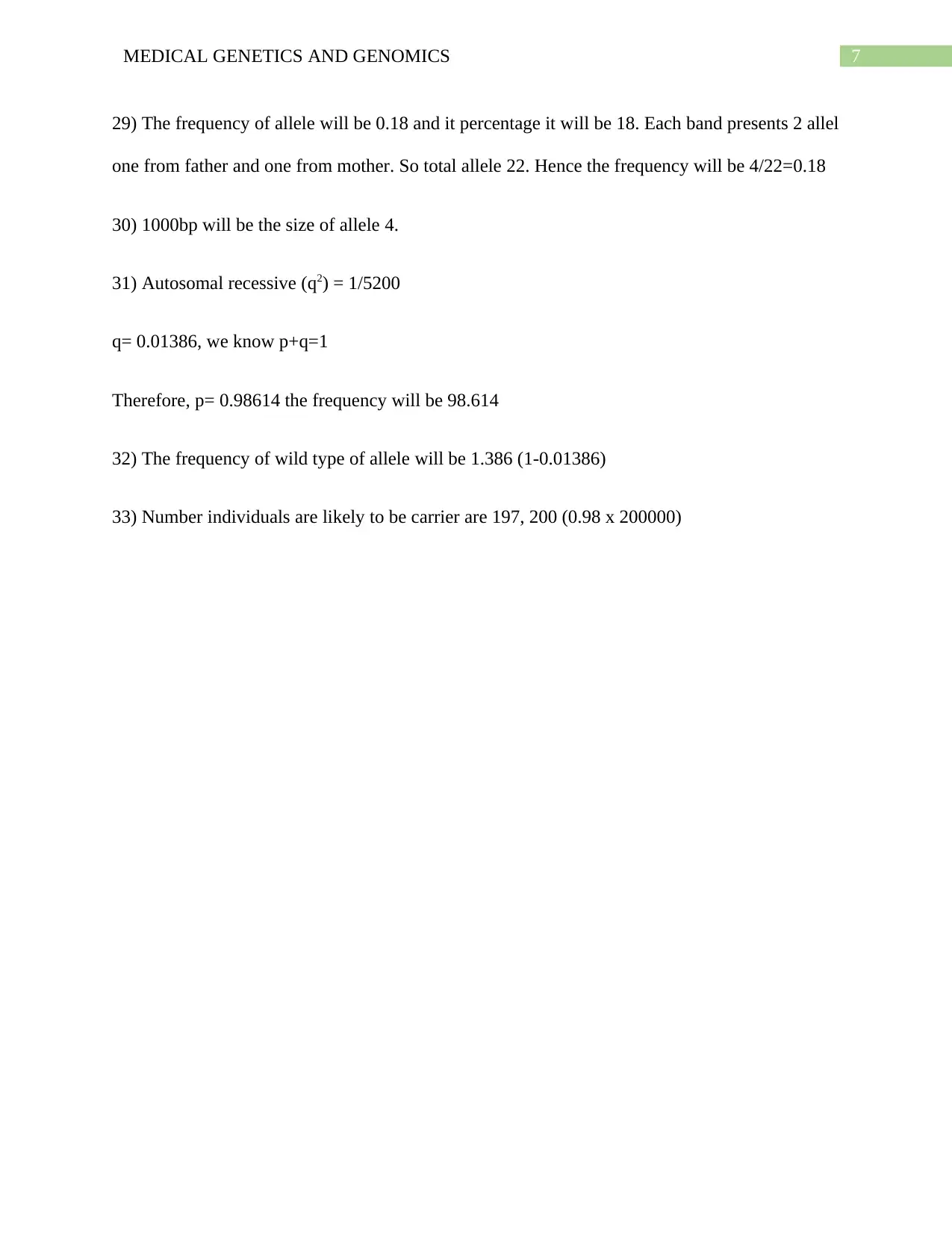
7MEDICAL GENETICS AND GENOMICS
29) The frequency of allele will be 0.18 and it percentage it will be 18. Each band presents 2 allel
one from father and one from mother. So total allele 22. Hence the frequency will be 4/22=0.18
30) 1000bp will be the size of allele 4.
31) Autosomal recessive (q2) = 1/5200
q= 0.01386, we know p+q=1
Therefore, p= 0.98614 the frequency will be 98.614
32) The frequency of wild type of allele will be 1.386 (1-0.01386)
33) Number individuals are likely to be carrier are 197, 200 (0.98 x 200000)
29) The frequency of allele will be 0.18 and it percentage it will be 18. Each band presents 2 allel
one from father and one from mother. So total allele 22. Hence the frequency will be 4/22=0.18
30) 1000bp will be the size of allele 4.
31) Autosomal recessive (q2) = 1/5200
q= 0.01386, we know p+q=1
Therefore, p= 0.98614 the frequency will be 98.614
32) The frequency of wild type of allele will be 1.386 (1-0.01386)
33) Number individuals are likely to be carrier are 197, 200 (0.98 x 200000)
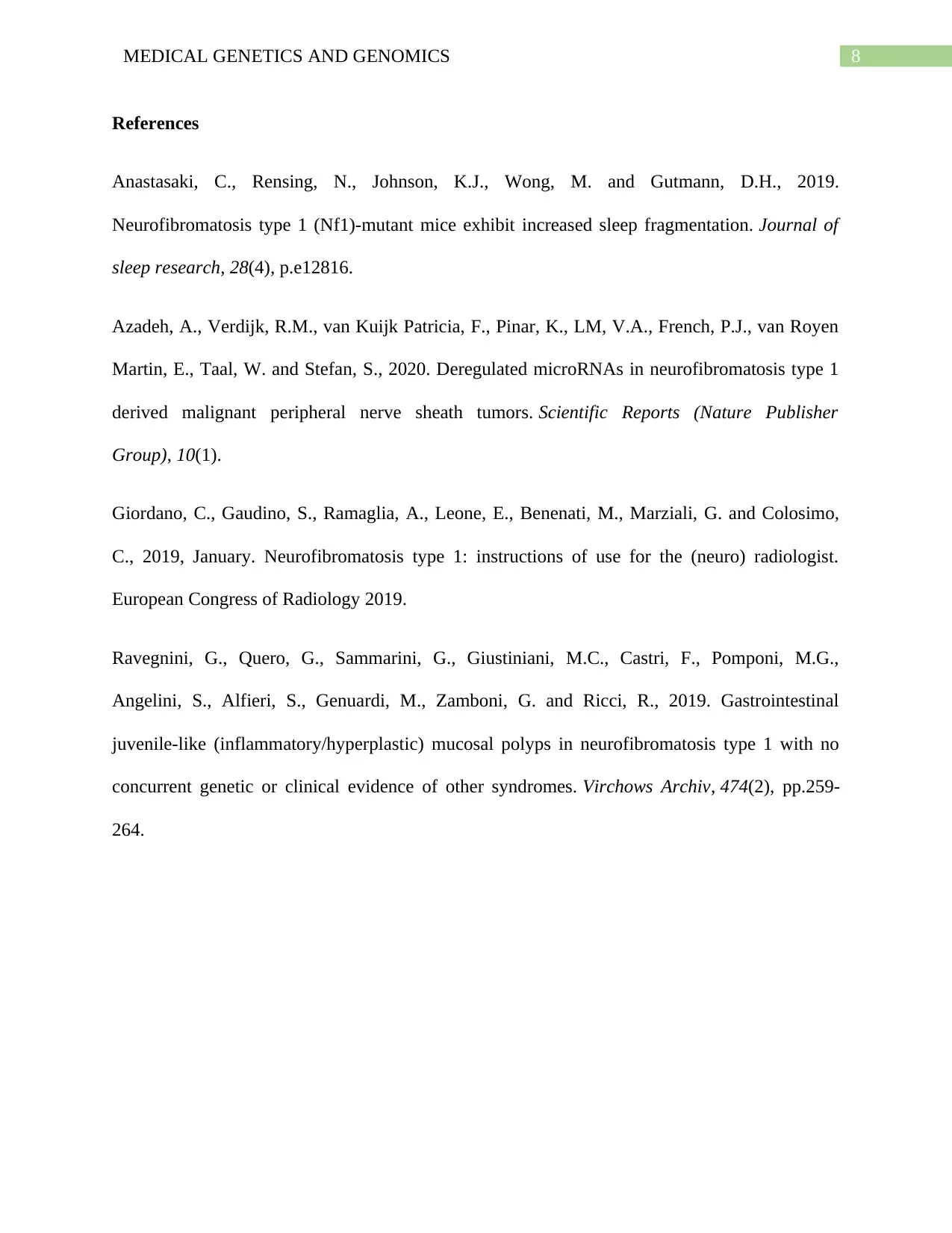
8MEDICAL GENETICS AND GENOMICS
References
Anastasaki, C., Rensing, N., Johnson, K.J., Wong, M. and Gutmann, D.H., 2019.
Neurofibromatosis type 1 (Nf1)‐mutant mice exhibit increased sleep fragmentation. Journal of
sleep research, 28(4), p.e12816.
Azadeh, A., Verdijk, R.M., van Kuijk Patricia, F., Pinar, K., LM, V.A., French, P.J., van Royen
Martin, E., Taal, W. and Stefan, S., 2020. Deregulated microRNAs in neurofibromatosis type 1
derived malignant peripheral nerve sheath tumors. Scientific Reports (Nature Publisher
Group), 10(1).
Giordano, C., Gaudino, S., Ramaglia, A., Leone, E., Benenati, M., Marziali, G. and Colosimo,
C., 2019, January. Neurofibromatosis type 1: instructions of use for the (neuro) radiologist.
European Congress of Radiology 2019.
Ravegnini, G., Quero, G., Sammarini, G., Giustiniani, M.C., Castri, F., Pomponi, M.G.,
Angelini, S., Alfieri, S., Genuardi, M., Zamboni, G. and Ricci, R., 2019. Gastrointestinal
juvenile-like (inflammatory/hyperplastic) mucosal polyps in neurofibromatosis type 1 with no
concurrent genetic or clinical evidence of other syndromes. Virchows Archiv, 474(2), pp.259-
264.
References
Anastasaki, C., Rensing, N., Johnson, K.J., Wong, M. and Gutmann, D.H., 2019.
Neurofibromatosis type 1 (Nf1)‐mutant mice exhibit increased sleep fragmentation. Journal of
sleep research, 28(4), p.e12816.
Azadeh, A., Verdijk, R.M., van Kuijk Patricia, F., Pinar, K., LM, V.A., French, P.J., van Royen
Martin, E., Taal, W. and Stefan, S., 2020. Deregulated microRNAs in neurofibromatosis type 1
derived malignant peripheral nerve sheath tumors. Scientific Reports (Nature Publisher
Group), 10(1).
Giordano, C., Gaudino, S., Ramaglia, A., Leone, E., Benenati, M., Marziali, G. and Colosimo,
C., 2019, January. Neurofibromatosis type 1: instructions of use for the (neuro) radiologist.
European Congress of Radiology 2019.
Ravegnini, G., Quero, G., Sammarini, G., Giustiniani, M.C., Castri, F., Pomponi, M.G.,
Angelini, S., Alfieri, S., Genuardi, M., Zamboni, G. and Ricci, R., 2019. Gastrointestinal
juvenile-like (inflammatory/hyperplastic) mucosal polyps in neurofibromatosis type 1 with no
concurrent genetic or clinical evidence of other syndromes. Virchows Archiv, 474(2), pp.259-
264.
⊘ This is a preview!⊘
Do you want full access?
Subscribe today to unlock all pages.

Trusted by 1+ million students worldwide
1 out of 9
Related Documents
Your All-in-One AI-Powered Toolkit for Academic Success.
+13062052269
info@desklib.com
Available 24*7 on WhatsApp / Email
![[object Object]](/_next/static/media/star-bottom.7253800d.svg)
Unlock your academic potential
Copyright © 2020–2025 A2Z Services. All Rights Reserved. Developed and managed by ZUCOL.





